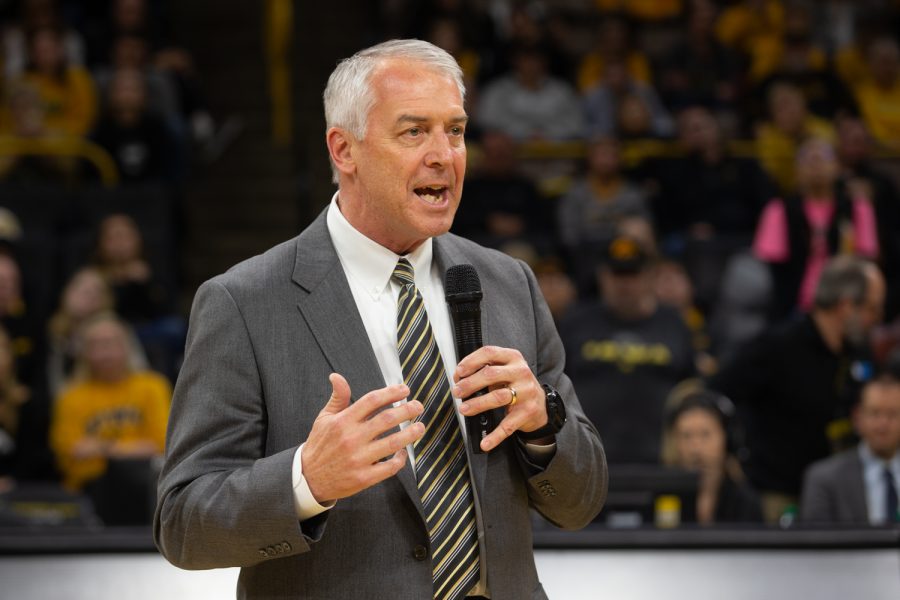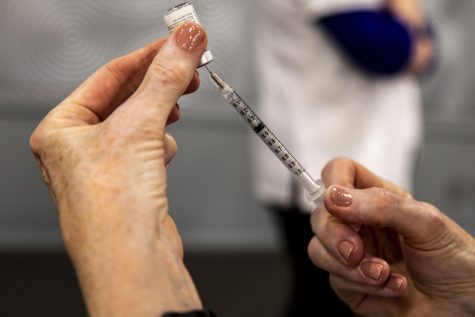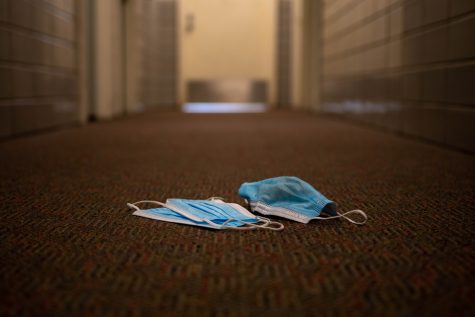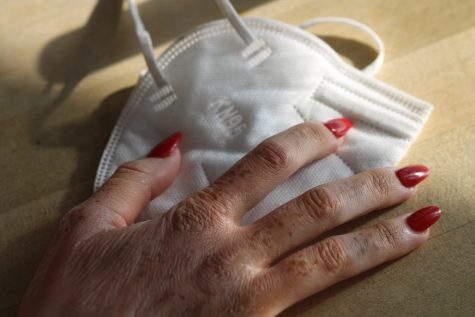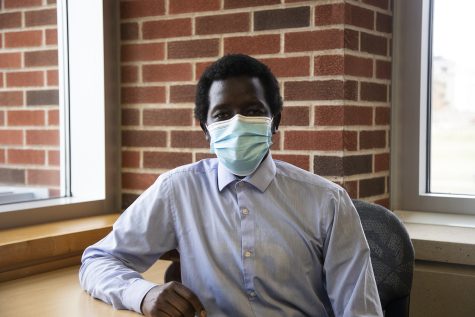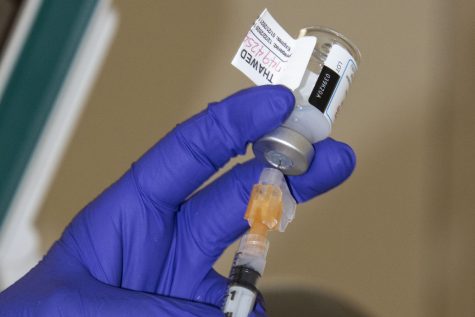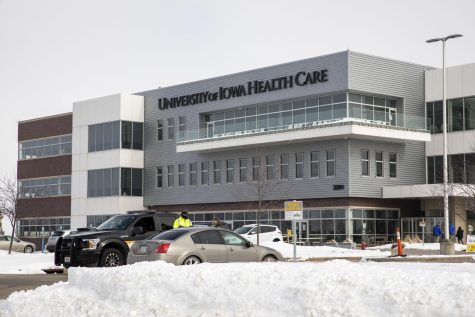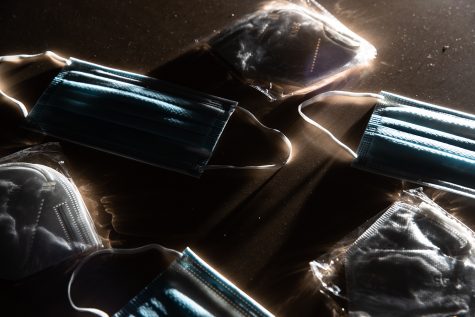Iowa AD Gary Barta anticipates financial changes within athletic department amid COVID-19
The fluidity of the COVID-19 pandemic makes financial projections difficult.
University of Iowa athletic director Gary Barta discusses former Iowa basketball player Megan Gustafson’s career during the retirement ceremony for her number 10 jersey following the Iowa women’s basketball game against Michigan State University on Sunday, Jan. 26, 2020 at Caver-Hawkeye Arena. The Hawkeyes defeated the Spartans, 74-57.
April 9, 2020
On a Thursday video conference, Iowa Athletic Director Gary Barta said he expects pay cuts and budgetary restrictions within the athletic department stemming from the COVID-19 pandemic.
Barta said he did not have an exact number for the amount of revenue Iowa lost due to the cancellations caused by coronavirus. The athletic department runs on a fiscal schedule that runs through June 30, and by that time Barta said he will know the final contributions Iowa will get from revenue streams and put an exact figure on financial losses.
“We started a hiring freeze, we started a spending freeze, and the only expenditures are going to be focused on things that we had contractually committed,” Barta said. “Things that we had already spent, basically.”
Following University of Iowa President Bruce Harreld’s announcement that UI employees will be in “paid status” through the end of the semester, Barta said that employees in the athletic department will continue to be paid through June 30.
“We believe right now, unless something significant changes that I don’t anticipate, we will be able to keep everyone employed through June 30,” Barta said.
“If things come in the way we’ve portrayed them or estimated them, we believe we can cover everything without cuts in pay right now, without letting anybody go or any furloughs, and cover everything with reserves through June 30.”
Looking ahead to the next athletic year, Barta said, like everyone, he is uncertain of what to expect.
“We have started modeling,” Barta said. “We know our revenue is going to be less next year. I think everyone in America, their finances, their business finances, certainly the University of Iowa, is expecting less revenue next year.”
To this point, Barta has not asked any staff member to take a pay cut moving forward. Under the current financial circumstances, however, a reduction in spending is expected to come into play, including on staff salaries.
“One of the larger expenses on our budget is compensation of 250 full-time employees,” Barta said. “I expect there will be a reduction. We have to reduce that expenditure. I’m not going to predict how much yet, and I’m not going to predict who. I anticipate most everybody if not everybody will be involved in that — a shared sacrifice.”
That sacrifice will expand to just about every expense the athletic department has on its budget.
“Everything that we do I anticipate is going to be reduced, except for the scholarship bill,” Barta said. “Our scholarship bill is usually between $13 and $14 million, and that is a commitment. We’re not planning on taking any money from any student athletes.”
Timeline for the football season
Iowa football’s first game of the season is not until Sept. 5, but there is still concern that the country will not be at a point where it is safe to host events of that size.
“Everybody involved wants to make that happen,” Barta said. “First and foremost, we have to know that the participants can be safe. It’s going to be driven by bringing people back safely. It’s going to be conversations about how long does a team need, how long does a student athlete need to be safe and prepared to come back and play a football season.”
Barta said he is on the phone with athletic directors from the Big Ten and the conference’s commissioner every day. He also said that he is in regular communication with Iowa head football coach Kirk Ferentz and the NCAA.
“We’ve been modeling,” Barta said. “What does that look like, how soon would we have to report to camp to play a season on time, if we had to push the season back how would that look and could we still have a full season?”
Before tournaments and spring sports were canceled by the Big Ten and the NCAA, there was the possibility that those events would be played without fans in attendance. Barta said he could see that as a scenario for football games in the fall and that he was open to whatever was safest for all involved.
Pushing the football season back to start at a later date has also been discussed, Barta said, but no specifics have been ironed out.
Mostly as it related to football, Barta stressed that games will not be played until it is safe to do so, and when that happens it will be a big step for Iowa City and the University of Iowa.
“Everybody wants to get back to normal, whatever the new normal is,” Barta said. “I know a lot of people would feel a little bit of healing will go on once we get back into Kinnick Stadium.”
Spring sport eligibility
On March 30, the NCAA officially announced that it had granted spring-sport athletes permission to receive an additional year of eligibility. Leading up to that point, Barta told various coaches to reach out to their athletes to discuss how they wanted to move forward.
“We started talking to our coaches when we knew that was something that was being talked about,” Barta said. “We asked our coaches to start having conversations with our student athletes, the seniors in particular. Every senior’s story is a little bit unique, a little bit different.
“Most of the spring sport student athletes are on partial scholarships as opposed to full scholarships. Going to them and talking to them about if they even want to come back. If you do come back, what if you don’t have scholarship money? What if we do have scholarship money and it is less?”
Barta said that as of now, roughly 25-35 seniors have expressed an interest in coming back for another year across various spring sports. He said that would cost the department roughly $500,000.



